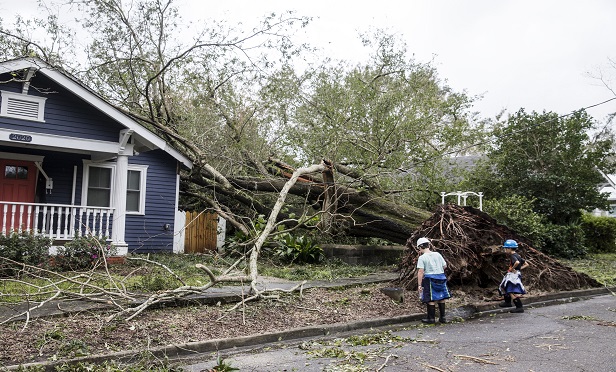 Children look at a fallen tree lying on a damaged home after Hurricane Florence hit in Wilmington, North Carolina, U.S., on Saturday, Sept. 16, 2018. In flooded communities, emergency workers have rescued more than 900 people as still-potent remnants of Hurricane Florence march through North Carolina. (Photo: Alex Wroblewski/Bloomberg)
Children look at a fallen tree lying on a damaged home after Hurricane Florence hit in Wilmington, North Carolina, U.S., on Saturday, Sept. 16, 2018. In flooded communities, emergency workers have rescued more than 900 people as still-potent remnants of Hurricane Florence march through North Carolina. (Photo: Alex Wroblewski/Bloomberg)
Updated: 10:30 a.m. EST, September 19, 2018.
As North Carolina reels from the destruction caused by Hurricane Florence, early insured loss estimates are coming in. While these numbers become available, it’s important to note that the industry won’t know any official loss numbers for weeks, if not months, at the earliest.
Catastrophe modeler Karen Clark & Co. (KCC) estimates that the insured loss from Hurricane Florence will be $2.5 billion. This estimate includes the privately insured wind, storm surge, and inland flooding damage to residential, commercial, and industrial properties and automobiles. It does not include NFIP losses.
Willis Towers Watson estimates insured losses to fall between $2.5 billion to $5 billion.
A third source, AIR Worldwide estimates that industry insured losses resulting from Hurricane Florence’s winds and storm surge will range from $1.7 billion to $4.6 billion. These estimates do not yet include the ongoing flooding throughout the effected areas.
Related: Florence’s floods obscure damage inflicted on Carolinas
In a statement, Gary Marchitello, Head of Property Broking at Willis Towers Watson explained that the lower wind speeds will likely make Florence more of a flood event, for which insurance penetration rates are generally low, rather than one featuring wind damage, which tends to be more traditionally insured.
Marchitello expects the industry will see some short term disruption in the market from Florence, but nothing long-term. He advises companies, particularly those with catastrophe exposures, to start their insurance program renewal process early, and ensure their information for underwriters is up-to-date.
Feeling Florence’s wrath
Florence reached maximum wind speeds of 140 mph on September 10. The storm weakened significantly before making landfall on September 14 near Wrightsville Beach, North Carolina, with Category 1 wind speeds.
Slow-moving Florence brought heavy rainfall in excess of 30 inches to parts of North Carolina. Peak surge from Hurricane Florence reached 10 feet in New Bern, North Carolina, and other areas of the state including Beaufort and Wilmington had significant storm surge impacts.
North Carolina received most of the blow, and will continue to experience serious flooding events throughout the week.
Hurricane force winds were experienced only along the North Carolina coast, but tropical storm force winds were recorded across much of North and South Carolina, and created significant damage to the area. Almost one million households lost power due to falling trees and power lines, KCC reports.
South Carolina Department of Insurance Director Ray Farmer said much of the damage experienced in the Palmetto State over the weekend caused by wind. He warned that going forward, the biggest threat facing residents over the coming days is flash flooding, noting that the damage is far from over.
Related: At least 17 dead as Florence brings catastrophic flooding to Carolinas
Got photos to share? We’d like to see them. PropertyCasualty360.com readers who have images of Florence’s path can send them via e-mail to [email protected], for inclusion in our coverage.















 Copyright © 2024 ALM Global, LLC. All Rights Reserved.
Copyright © 2024 ALM Global, LLC. All Rights Reserved.